Concept 10.3: The light reactions convert solar energy to the chemical energy of ATP and NADPH
1/16
Name | Mastery | Learn | Test | Matching | Spaced |
|---|
No study sessions yet.
17 Terms
Chloroplasts
Solar-powered chemical factories
Thylakoids transform light energy into the chemical energy of ATP and NADPH, providing energy and reducing power needed by the Calvin cycle to make sugar
Electromagnetic energy (electromagnetic radiation)
Energy that travels in rhythmic waves via electromagnetic forces; light is one example
Wavelength
A measure of the distance between crests of electromagnetic waves
Can range from less than a nanometer (gamma rays) to more than a kilometer (radio waves)
Electromagnetic spectrum
The entire range of electromagnetic energy, or radiation
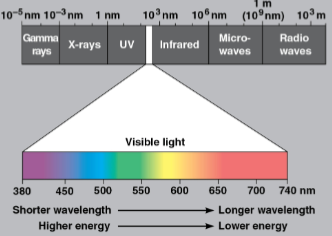
Visible light (visible spectrum)
The electromagnetic spectrum between wavelengths 380 nm to 740 nm which drive photosynthesis and produce the colors seen by the human eye
Photons
Discrete particle-like units of light
Each particle has a fixed quantity of energy inversely related to the wavelength of the light — shorter wavelengths have more energy per photon
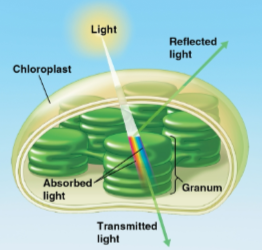
Pigments
Substances that absorb visible light; differs for every type
Wavelengths that are absorbed disappear, while wavelengths that are not absorbed are reflected or transmitted
Most leaves appear green because the pigment chlorophyll absorbs violet-blue and red light while reflecting and transmitting green light
Light causes electrons in a pigment to go to an unstable excited state, which can later fall back to a ground state releasing energy as heat or light
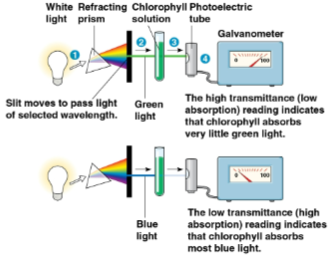
Spectrophotometer
A device that measures a pigment’s ability to absorb various wavelengths, sending light through pigments and measuring the fraction of light transmitted at each wavelength
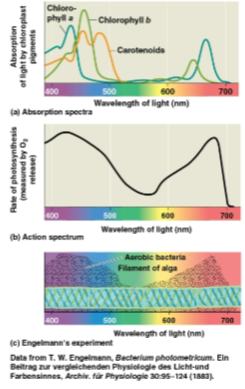
Absorption spectrum
A graph plotting a pigment’s light absorption versus wavelength
Chlorophyll a
The key light-capturing pigment that participates directly in light reactions
Absorbs violet-blue and red light for photosynthesis for most energy while reflecting green light
Chlorophyll b
An accessory pigment to chlorophyll a
Carotenoids
A separate group of accessory pigments to chlorophyll a, absorbing violet and blue-green light and thus broadening the spectrum for photosynthesis
Some can also absorb excessive light that would otherwise damage chlorophyll or react with oxygen

Action spectrum
A profile of the relative effectiveness of different wavelengths
Higher for violet-blue and red light in photosynthesis
Broader for overall photosynthetic processes in combination with chlorophyll b, due to a slight structural difference in the pigment molecules
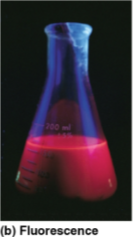
Fluorescence
The release of excess energy by electrons in the form of light
Photosystem
A reaction-center complex surrounded by light-harvesting molecules
Photosystem II (PS II)
Also known as P680, it is the first photosystem in the thylakoid membrane that functions best with absorbing light with chlorophyll a at 680 nm
Named for its secondary discovery to Photosystem I
Photosystem I (PS I)
Also known as P700, it is the second system in the thylakoid membrane that functions best with absorbing light with chlorophyll a at 700 nm
Named for it being discovered first before Photosystem II